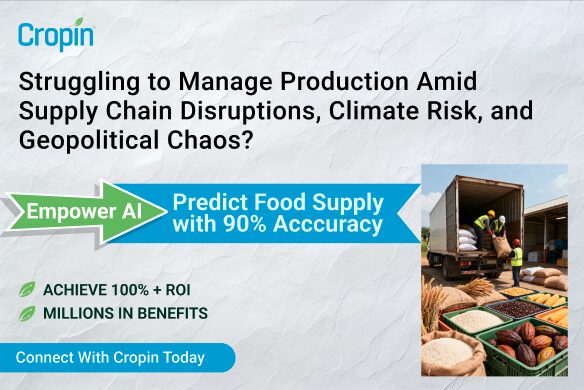Transparency was already a high priority for consumers before the pandemic hit. Now, it’s even more critical with 81% of consumers recently deeming it “extremely important”, according to a report from the Food Marketing Institute and Label Insight.
Consumers also want to know that the products they’re buying are making a positive impact on the environment but aren’t always ready to give up other priorities like convenience or price point.
This creates a conundrum for many brands. Improving sourcing or production practices, sharing more about the process with consumers, and keeping costs low is a tall order.
Innovation to the rescue…
“Technology is a key enabler for driving sustainability because it increases visibility across the supply chain, helping us to ensure that our ingredients are sustainably grown,” Giulia Stellari, director of sustainable sourcing at Unilever, told AFN.
Her work focuses on digital and carbon solutions for the multinational consumer goods company. It boasts 400 individual brands in its portfolio spanning food, beverage, cleaning, and personal care products. She’s tasked with leading the brand’s decarbonization efforts with suppliers and digital enablers that can help transform the supply chain.
“As an example, before being processed, crops such as palm oil fruit or soy can be harvested from many different areas of land, belonging to numerous farmers, and mixed with raw material from other farms several times over before even reaching the mill. To ensure that the land used to grow crops such as palm oil fruit and soy isn’t connected to deforestation, we’re reimagining our approach to traceability so we can do even more to protect forests. That’s where technology comes in and can help make a big difference.”
For all the tech that’s currently available, however, there is plenty of room for more innovation.
“Getting a better handle on biodiversity through technology, for example, can help us monitor the impacts of our supply chains at scale and identify where we can take action to have a positive impact on biodiversity.”
Stellari participated in a panel discussion at the virtual World Agri-Tech Innovation Summit this week entitled ‘Radical Transparency in the Food Supply Chain Powered by Technology.’ It was part of the event’s Supply Chain Transparency and Resiliency Track. You can watch her panel discussion on demand through the virtual platform until October 16.
The event’s organizers will also be hosting the online Future Food-Tech Summit from tomorrow and the Asia-Pacific Agri-Food Innovation Summit from November 18-20. You can still sign up to attend both.
China’s consumer digital revolution now reaches ‘back into the supply chain and the farm’ – read more from World Agri-Tech Innovation speakers here
The event’s organizers will also be hosting the online Future Food-Tech Summit from tomorrow, and the Asia-Pacific Agri-Food Innovation Summit from November 18-20. You can still sign up to attend both.
Read on to learn more about how Unilever is approaching technology and sustainability through the lens of transparency.
AFN: How has the conversation around sustainability evolved at Unilever over the last five years?
Giulia Stellari (GS): This is in the foundations of Unilever and we’ve been working on it for some time. Ten years ago, we introduced our Sustainability Living Plan – our blueprint for how we do business. At the time it was a game-changer with very ambitious targets. As we look back over our ten-year journey so far, we have much to be proud of. We’ve had a positive impact on the lives of millions of people, and on the planet. Some of our achievements in these last 10 years include:
- 62% of our agricultural raw materials are sustainably sourced – which is up considerably from 14% a decade ago.
- Reaching 1.3 billion people through our health and hygiene programs.
- Reducing the total waste footprint per consumer use of our products by 32% and achieving zero waste to landfill across all our factories.
- Reducing greenhouse gas emissions from our own manufacturing by 65% and achieving 100% renewable grid electricity across our sites.
- Enabling 2.34 million women to access initiatives aiming to promote their safety, develop their skills or expand their opportunities, we’ve moved towards a gender-balanced workplace in which 51% of management roles are held by women.
What are some of the biggest challenges you face?
Back in 2010, we set ourselves the goal of sourcing 100% of our agricultural raw materials sustainably. Of all our Unilever Sustainable Living Plan (USLP) goals, this was perhaps the most ambitious. We are currently at 62% – which is short of our target, but up considerably from 14% a decade ago.
Experience has taught us that our influence for change is greatest where we have the clearest line of sight throughout the chain – so that’s where we are focusing.
Delivering on this next level is something we remain very much committed to. One of the main challenges relates to the sheer variety of raw materials that we source. Take starch, for example, which we use right across our brand portfolio. Just one container of this multi-functional additive could easily contain 50 different plant ingredients. The logistical exercise of tracing each and every one of these materials back to its original farm, field, or plantation is very lengthy and complex.
Typically, we are buying from large suppliers, who very often source from smaller suppliers, and so on down the chain. As a result, it is often not possible to gain full visibility of the entire chain. This problem is often most acute for those raw materials that undergo some form of processing before arriving at our factories – with starch, once more, an emblematic case in point.
We believe the most important priority is to focus our efforts where we can have the highest impact. This decision had led us to a list of 12 key ingredient categories to focus on, including all commodities such as sugar, palm oil, soy, cocoa, paper, board, and tea. Collectively, these comprise about two-thirds of our total volume of agricultural raw materials, 88% of which are sustainably sourced.
In parallel, we will continue to work with farmers, suppliers, governments, and civil society to promote sustainable agriculture and forestry systems beyond the boundaries of our own business needs.
Which technologies do you find particularly promising?
Recently we announced a pilot with Orbital Insight, a US tech company that specializes in geospatial data analysis. The pilot uses geolocation data to help identify the relationships in our supply chain, helping us link the mills and refineries in our supply chains to their farms and plantations.
The technology leverages GPS data – aggregated and anonymized – to allow Orbital Insight to spot traffic patterns. Where there is a consistent flow of traffic between an area of land and a mill, it suggests a potential link.
This means we can get a much clearer picture of where harvested crops are coming from, even down to the individual field. This, in turn, allows us to predict the possibility of issues such as deforestation.
What do you wish consumers understood better about Unilever’s sustainability?
Unilever truly believes that growth doesn’t have to come at the expense of people and the planet and that businesses can be a force for good – through actions, not just words. 10 years ago, we launched probably the most comprehensive range of sustainability targets that any business of our size had ever set. In June this year, we committed to a new range of measures and commitments designed to improve the health of the planet by taking even more decisive action to fight climate change and protect and regenerate nature, to preserve resources for future generations.
Unilever committed to achieving Net Zero emissions from all our products by 2039, to a deforestation-free supply chain by 2023, and to work with a new generation of farmers and smallholders, driving programs to protect and restore forests, soil, and biodiversity. To accelerate action, Unilever’s brands will collectively invest €1 billion in a new dedicated Climate & Nature Fund. This will be used over the next ten years to take meaningful and decisive action, with projects likely to include landscape restoration, reforestation, carbon sequestration, wildlife protection, and water preservation.
What do you think about carbon markets for agriculture?
Decarbonizing agriculture is a huge opportunity to make progress towards a net-zero world by 2050. Unilever has committed that its products will have net zero emissions from cradle to shelf by 2039, so we need to look at the decarbonization of our materials and ingredients from agriculture to achieve this. We are looking at the potential for soil carbon sequestration and following the new developments in the science closely.
Covid-19 is changing our food system. What permanent changes will result from the pandemic?
Everyone’s reality has changed. People, governments, and businesses have all seen what a global crisis, long-predicted by scientists, can actually do. This is an opportunity for us all to recognize that collective action is needed to address climate change and protect biodiversity. The pandemic has accelerated in just weeks things that were taking decades. People quickly adjusted and embraced new habits because they had to – we should remember this lesson when thinking about the climate emergency. The pandemic needs to become a turning point in our response to climate change and the destruction of nature.
What is one thing that has surprised you about your work in food system sustainability?
A lot has surprised me but if I had to point to one thing it is how vast and interconnected supply chains are. We like to portray them as a linear chain, but they are more like webs so tracing them back to origin is a real challenge. It is a great opportunity to innovate with technology as well.





